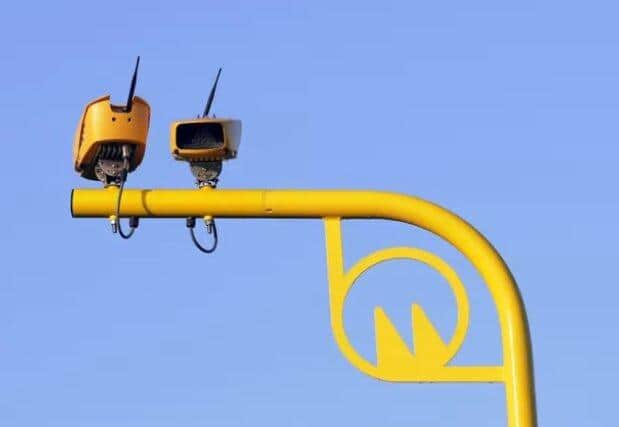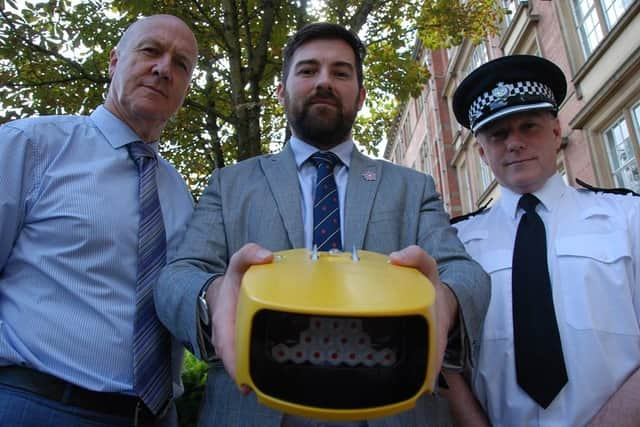These are the five 'most dangerous' roads in Lancashire where new average speed cameras are being installed
and live on Freeview channel 276
The devices will be rolled out between now and next spring on routes which have been deemed to be the most dangerous in the county.
Work has already begun at one of the sites, in Chorley, following a recent decision by Lancashire County Council’s cabinet to approve associated speed limit reductions at some of the locations.
Advertisement
Hide AdAdvertisement
Hide AdThe £5m scheme will be funded from a £7.9m grant awarded to the authority by The Road Safety Foundation, a charity which aims to reduce the number of casualties on the nation’s highways.


In association with the Department for Transport, the foundation established the Safer Roads Fund to target the 50 most high-risk sections of A-road in England with a range of safety interventions. Five of those routes were identified as being in Lancashire - with two in the top ten - and the county council was successful in its bid for a share of the fund as a result.
Papers presented to cabinet earlier this month noted that the programme was distinctive in that it used “a proactive approach to work out how to reduce risk on a road”.
“Traditionally, steps are taken to improve safety after collisions have occurred, but this new approach uses road engineering to try and prevent accidents from happening in the first place,” the report added.
Advertisement
Hide AdAdvertisement
Hide AdAverage speed cameras have been in use on several of Lancashire’s busiest roads for five years - including the A6, London Road, in Preston and the A583, Blackpool Road, in Fylde - to identify vehicle speeds over a wide area, rather than at a fixed point. They aim to encourage consistent compliance with speed limits rather than adherence just at the moment when a motorist passes a standalone camera.


WHERE WILL THE CAMERAS BE?
The five new locations where the devices will be installed are:
***A581 between Rufford and Euxton (work under way)
*** A588 between Lancaster and Skippool (work starts in November)
*** A683 in Lancaster from junction 34 of the M6 to Kirkby Lonsdale (work starts early January)
Advertisement
Hide AdAdvertisement
Hide Ad***A6 in Lancaster between the city centre and J33 of the M6 motorway (work starts late February)
***A682 in Ribble Valley from Gisburn to the boundary with North Yorkshire at Long Preston (work starts in March)
Traffic management restrictions will be required during the installation process and a period of testing will be needed after the cameras are put in place before they can be made operational and begin being used by police to enforce speed limits.
Charlie Edwards, cabinet member for highways and transport at County Hall, told a meeting of his cabinet colleagues that “a huge amount of work has gone [on] in terms of [road markings], installing studs [and] crash barriers and other forms of protective measures” on the roads in question.
Advertisement
Hide AdAdvertisement
Hide AdHowever, he said that one of the most important elements of the current efforts to improve safety was to ensure that the speeds are “right” on the high-risk routes that have received cash from the Safer Roads Fund.
“A lot of work has actually gone into identifying ..what should the speed limits be on these roads. And so...a number of consultations have [been undertaken] to work out [whether] these speeds are right - or should we be lowering them in certain places?” County Cllr Edwards explained.
The limits have been reviewed on longer streches of the routes than those sections that will be covered by the new average speed cameras.
Cabinet gave the green light to reduced maximums of 50mph - where 60mph had previously been the top speed - on sections of the A588 through Pilling, Cockerham, Thurnham and Lancaster; parts of the A683, including between Caton and Burrow; and sections of the A6 around the Tollbar junction at Claughton and the traffic lights at the Croston Road junction in Garstang.
Advertisement
Hide AdAdvertisement
Hide AdSome respondents to the public consultations into the plans called for limits to be lowered even further, while others sought to preserve the so-called ‘national speed limits’ currently in place.
However, highways officials decided not to deviate from any of their original proposals. They said of the revised limits on the A588 - one of the ten most dangerous routes nationwide - that the reduction “balanc[ed] the need to improve road safety, but also to provide for the reasonable movement of traffic”.
Fellow top ten blackspot, the A683, was said to benefit from a 50mph limit on stretches with a “higher prevalence of bends, junctions and other highway features, including adjacent development, together with increased traffic volumes”. However, the national speed limit has been retained for those sections which do not meet that criteria.
Meanwhile, on the relevant stretches of the A6 around Claughton and Garstang, where parish councillors had called for 40 or even 30mph limits because of the level of housing development in the area, highways bosses said that the new dwellings were “predominantly contained behind high boundary hedges and on separate access roads”, meaning that the main road “would not meet the requirements” for a reduction below 50mph.
Advertisement
Hide AdAdvertisement
Hide AdCounty Cllr Aidy Riggott, a cabinet member and representative of the Euxton, Buckshaw and Astley division, said that the cameras now being put in place on the A581 would be welcomed by residents who had been “longing” for them.
“It will definitely improve road safety,” he added.
Labour opposition group leader Azhar Ali also gave the new schemes the thumbs up, but said that there was an opportunity to work more closely with town and parish councils in order to fund the huge costs of speed cameras in some of the areas where they are being called for by residents. - and he called for such collaboration to be made more of a priority.
County Cllr Edwards said that the issue of funding for new cameras was one that was often raised - and that he would like to see “far more enforcement” on Lancashire’s roads.
He told the meeting that the county’s road safety strategy - developed by a range of organisations - had recently undergone a review and would be brought back before the county council for final approval.
Advertisement
Hide AdAdvertisement
Hide AdHe added that he fully supported the aim of the national Project Edward campaign - to go “every day without a road death”.
“The most important thing is that speed cameras are just one measure to improve road safety. There is a huge amount that can be done in terms of the design of the road[s] - and there’s also a huge amount of work that needs to be done in terms of actual engagement and education with drivers [and] motorcyclists,” County Cllr Edwards said.
Speaking after the meeting, he added that the cameras being installed on the county’s most dangerous routes should be a “game changer”.in reducing the number and severity of incidents along their length.
"These are routes which rely on drivers exercising good judgement, being mainly rural in nature, and with features such as tight corners and junctions, where the history of serious incidents over the years have generally been clustered.”
IN NUMBERS
Advertisement
Hide AdAdvertisement
Hide Ad5 - new routes where average speed cameras will be installed in Lancashire
8 - routes in Lancashire already covered by average speed cameras
86 percent - the level up to which there has been a reduction in collisions on those routes
2017/18 - when the first average speed cameras were installed in Lancashire
Source: Lancashire County Council
POLICING YOUR SPEED
Advertisement
Hide AdAdvertisement
Hide AdIn a statement to mark the start of the average speed camera installation work, Andrew Pratt, Lancashire’s deputy police and crime commissioner and chair of the Lancashire Road Safety Partnership, said: "Targeting dangerous drivers is a policing priority across Lancashire and evidence shows that speeding is a major factor in road deaths and serious collisions, with careless drivers putting their own lives and the lives of others at risk.
"This investment is a result of significant analysis by the Lancashire Road Safety Partnership and follows close working with local MPs, councillors and parish councillors who have all expressed their concerns on behalf of local residents and communities."
Supt Mark Morley, of Lancashire Police’s Tactical Operations Unit, added: "The introduction of average speed cameras in the county has been very successful and helped in the reduction of serious injury and fatal collisions.
"This latest investment is our next stop in helping to increase road safety for all motorists and pedestrians.
"We will continue in our efforts to reduce collisions resulting in death or serious injury, and I am confident using this type of enforcement will play a vital role in achieving these reductions."